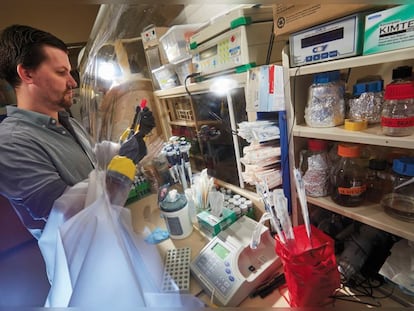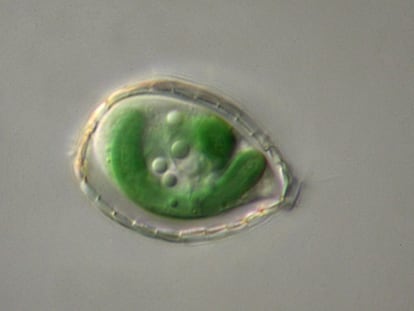Research indicates that gut flora are linked to children’s cognitive development
Certain bacteria may play a role in improving mental skills such as language expression and gross motor skills

With each new study on bacterial flora, the idea that there are two entities in every body gains traction: on the one hand, there’s the human being, and on the other, the person’s microbiome. It is a good thing that the two get along well. Recent work has shown the connection between certain intestinal bacterial profiles and mental health, even identifying the types of bacteria associated with depression. But if there are some microbes behind mental illnesses, do others favor better cognition? That is what the scientists who studied the relationship between the cognitive abilities of hundreds of children and the microbiota in their tummies suggest.
All signs indicate that children develop in their mother’s womb in a sterile, bacteria-free environment. “They are bathed in bacteria when they pass through the birth canal,” José Clemente, a professor at the Icahn School of Medicine at Mount Sinai Hospital in New York, explained a few years ago after performing the first maternal microbiome implant on children born by cesarean section. That bacterial bath is vital. Maternal intestinal and vaginal microbes thus colonize the child’s body to facilitate key functions, such as training the immune system and supporting the digestive system. During the first few months of life, breast milk or formula shapes a child’s early gut microbiome. It is not until children begin to eat solid food that their gut flora begin to resemble that of adults.
At the same time, young children’s brains undergo the biggest transformations of their entire lives: myelination, the development of protective sheaths for axons and neuron endings, becomes generalized. The critical phase of so-called synaptic pruning begins, a process by which most of the unnecessary connections formed almost at random in the first years of life are eliminated. Neurogenesis, which begins in utero, is in its most productive years. By the age of five, a child’s brain reaches 85% of the size it will be as an adult. During this time, the general pattern of brain connections is fixed, leaving a margin for plasticity that narrows further by the end of adolescence.
A large group of researchers, neurologists and pediatricians in the United States has researched possible relationships between the dizzying brain and mental development and intestinal flora in 381 children, between the ages of 40 days old and 10 years old. Recently published in the scientific journal Science Advances, the study was based on the idea that if certain bacterial profiles can be related to or affect certain mental pathologies, why wouldn’t other sets of bacteria influence the anatomy and cognition of the brains of young children?
To identify the gut flora, the researchers analyzed children’s stool samples, including a genetic examination to classify the different bacteria species, genera and families and their roles in metabolism. At the same time, they conducted a series of age-appropriate tests to determine the degree of each child’s cognitive abilities. Data collection work was completed by a series of brain scans of the children to determine their anatomy in detail.
The main difference has to do with age, and that was expected. Children six months old and younger have fewer bacteria in their intestines and fewer varieties of it. That changes, especially after 18 months, with an increase in both the diversity of species and the quantity. But research has also detected a parallel variation, suggesting a connection between the microbiome and results in the various cognitive tests. Specifically, certain gut microbial species, such as Alistipes obesi, Faecalibacterium prausnitzii and Blautia wexlerae, have a greater presence in the guts of children who achieved the best test scores. Conversely, researchers found that species like Ruminococcus gnavus and Sutterella wadsworthensis are more common in children with lower cognitive scores.
This study goes a bit further to examine the possible connection between specific microbiota species and specific abilities. In the same way that some bacteria have a metabolic function, such as processing a certain fatty acid, they also seem to specialize in some dimensions of cognition and not others. For example, researchers observed that two species of the genus Streptococcus (S. peroris and S. mitis) and Bacteroides fragilis are plentiful in children with better linguistic expression. Roseburia faecis, Streptococcus salivarius, and Fusicatenibacter saccharivorans may be involved in gross motor skills, and Clostridium innocuum and Bacteroides vulgatus are plentiful in the guts of children who excelled in visual perception.
It has been proven, in mice, that if you give them bacteria that are not abundant in people with depression, their symptoms improveMireia Vallès Colomer, a microbiologist at the University Pompeu Fabra
Kevin Bonham, a Wellesley College microbiologist and immunologist and the study’s lead author, is quick to caution against jumping to conclusions: “There are some mechanisms [of the connection between microbes and cognitive function] that have been demonstrated in other contexts, but I want to emphasize that in this study we were only looking at associations and cannot make any claims about causality.” But he does note some mechanisms through which microbes might be causally connected to cognitive function. “One is that bacteria can produce molecules that directly influence the nervous system,” he says. Indeed, during their metabolic activity, gut flora generate dopamine and serotonin, two neurotransmitters. “Others can activate the immune system and many of the immune signals can affect the brain,” Bonham adds. For example, certain bacterial species produce neuroactive compounds, such as short-chain fatty acids (butyrate or propionate) that reduce inflammation.
In their research, Bonham and the head of his laboratory, Vanja Klepac-Ceraj, the senior author of this study, used the catalog of these neuroactive components prepared by Mireia Vallès Colomer, who heads the Microbiome Research Group at Pompeu Fabra University (UPF) in Spain. “For many years, there was talk of people with depression, Parkinson’s disease, Alzheimer’s, who had greater amounts of some bacteria and lower amounts of others. It was nice to identify them, to give them a name. But what we see is that the microbiome is a super-complex ecosystem; the most important thing is not the presence of one bacterium or another, but the composition at the functional level: which bacteria reduce inflammation, which produce serotonin,” the microbiologist explains. That functional catalog was prepared as part of a research project on the microbiome and depression. The major novelty in the current study is its use in healthy children. But a cause-effect relationship has not yet been established in children or in depressive patients.
“It cannot be confirmed in humans yet,” Vallès stresses. “When we published our research in 2019, articles appeared with headlines like ‘depression bacteria discovered.’ But, for now, the only thing we know is that people who have depression have affectations in the microbiome, but we don’t know whether it is depression that causes this alteration, the other way around or neither of them.” However, she goes on to emphasize that “it has been shown in mice, with which this type of study can be conducted, that if you give them bacteria that are not abundant in people with depression, they improve in several symptoms.”
The dean of the University of Girona Medical School in Spain, Dr. José Manuel Fernández-Real, has been researching the microbiome-gut-brain axis for years. His pioneering work illustrated the mediation of the intestinal flora’s metabolic activity in the link between obesity and deficits in both short-term and working memory. He has serious doubts about the new study’s methodology: “They did not use conventional statistical techniques to analyze the microbiota’s composition, which is essential for avoiding erroneous associations in large volumes of data,” he says. According to Fernández-Real, “a more exhaustive review and the use of robust statistical techniques are necessary to strengthen the validity of the results and adequately contextualize this study’s contribution to the field.”
That is not to say that Fernández-Real rejects the connection between gut flora and cognition. In the adult population, “the link between the gut microbiota profile and cognitive functions has been extensively investigated,” Fernández-Real observes. For example, it has been suggested that “a balanced microbiota [in the context of a Mediterranean diet] may contribute positively to the preservation of brain function,” he adds. Although unraveling how that happens is more difficult, all signs indicate that bidirectional communication between the intestine and the brain, the aforementioned intestine-brain axis, could play a crucial role. As the dean notes, “Metabolites produced/metabolized by gut bacteria, such as short-chain fatty acids, may have neuroprotective effects and be related to cognitive function.”
There are already companies to which one can send a stool sample to profile one’s personal microbiome, including an assessment of the absences and stocks in the bacterial catalog. But Bonham doesn’t think that probiotics can make kids smarter or savvier: “It’s possible that this will happen someday, but the effects here are very small and, in any case, we’re a long way from that,” he says. For Bonham, it’s “most likely, someday we’ll be able to identify risk factors that might help us identify kids who might need a little more help, but I suspect that help will come from things we already know how to handle and not really from changing the microbiome.”
Sign up for our weekly newsletter to get more English-language news coverage from EL PAÍS USA Edition
Tu suscripción se está usando en otro dispositivo
¿Quieres añadir otro usuario a tu suscripción?
Si continúas leyendo en este dispositivo, no se podrá leer en el otro.
FlechaTu suscripción se está usando en otro dispositivo y solo puedes acceder a EL PAÍS desde un dispositivo a la vez.
Si quieres compartir tu cuenta, cambia tu suscripción a la modalidad Premium, así podrás añadir otro usuario. Cada uno accederá con su propia cuenta de email, lo que os permitirá personalizar vuestra experiencia en EL PAÍS.
¿Tienes una suscripción de empresa? Accede aquí para contratar más cuentas.
En el caso de no saber quién está usando tu cuenta, te recomendamos cambiar tu contraseña aquí.
Si decides continuar compartiendo tu cuenta, este mensaje se mostrará en tu dispositivo y en el de la otra persona que está usando tu cuenta de forma indefinida, afectando a tu experiencia de lectura. Puedes consultar aquí los términos y condiciones de la suscripción digital.
More information
Archived In
Últimas noticias
Half of Scotland is in the hands of 420 property owners
From digital curfews to blocking apps: How technology experts protect their children online
Why the price of coffee has skyrocketed: from Brazilian plantations to specialty coffee houses
Confined to a Cuban hospital: When electricity is a matter of life or death
Most viewed
- Why we lost the habit of sleeping in two segments and how that changed our sense of time
- Trump’s obsession with putting his name on everything is unprecedented in the United States
- Charles Dubouloz, mountaineering star, retires at 36 with a farewell tour inspired by Walter Bonatti
- The Florida Keys tourist paradise is besieged by immigration agents: ‘We’ve never seen anything like this’
- Living in a motorhome due to soaring housing prices in Madrid: ‘I got used to it quickly, but I don’t idealize it’











































